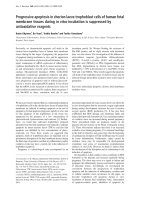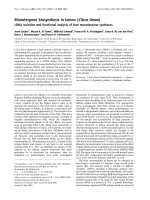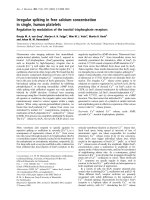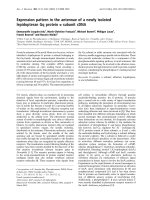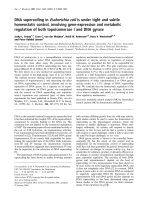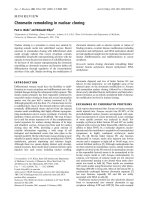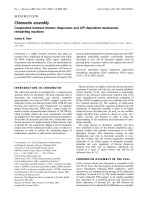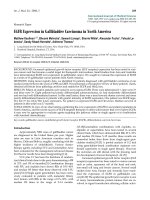Báo cáo Y học: Chromatin remodeling in nuclear cloning pptx
Bạn đang xem bản rút gọn của tài liệu. Xem và tải ngay bản đầy đủ của tài liệu tại đây (113.64 KB, 4 trang )
MINIREVIEW
Chromatin remodeling in nuclear cloning
Paul A. Wade
1
and Nobuaki Kikyo
2
1
Department of Pathology, Emory University, Atlanta, GA, USA;
2
Stem Cell Institute and Department of Medicine,
University of Minnesota, Minneapolis, MN, USA
Nuclear cloning is a procedure to create new animals by
injecting somatic nuclei into unfertilized oocytes. Recent
successes in mammalian cloning with differentiated adult
nuclei strongly indicate that oocyte cytoplasm contains
unidentified remarkable reprogramming activities with the
capacity to erase the previous memory of cell differentiation.
At the heart of this nuclear reprogramming lies chromatin
remodeling as chromatin structure and function define cell
differentiation through regulation of the transcriptional
activities of the cells. Studies involving the modification of
chromatin elements such as selective uptake or release of
binding proteins, covalent histone modifications including
acetylation and methylation, and DNA methylation should
provide significant insight into the molecular mechanisms of
nuclear dedifferentiation and redifferentiation in oocyte
cytoplasm.
Keywords: nuclear cloning; chromatin remodeling; linker
histone; histone acetylation; histone methylation; DNA
methylation.
INTRODUCTION
Differentiated somatic nuclei have the flexibility to dedif-
ferentiate in oocyte cytoplasm and redifferentiate into other
multiple lineages during the subsequent embryogenesis. This
drastic nuclear plasticity has been repeatedly confirmed by
successful nuclear cloning in frogs and several mammalian
species over the past half a century (reviewed in [1–3]).
Although generally only less than 1% of cloned mice survive
to adulthood [1], many of the aborted embryos still contain
terminally differentiated tissues derived from the injected
somatic nuclei establishing that highly efficient reprogram-
ming mechanisms exist in oocyte cytoplasm. Currently, the
identities of these activities are ill defined. The toad Xenopus
laevis and the mouse represent two of the complementary
model organisms for nuclear cloning. Because of its large
and abundant oocytes, Xenopus has been used for nuclear
cloning since the 1950s, providing a great amount of
valuable information regarding a wide range of cell
biological and biochemical events that take place in the
injected nuclei [2]. On the other hand, mouse cloning is more
suitable for genetic studies such as the modification of DNA
methylation, genomic imprinting and telomere length.
Although these two species display distinct early develop-
mental processes, these nuclei share common features upon
injection into each oocyte including nuclear swelling,
chromatin dispersal and loss of linker histone H1 (see
below). In this minireview, we will highlight some of the
selected topics on the chromatin modification in Xenopus
and mammalian nuclear cloning, followed by a discussion
about newly identified histone methylation and heterochro-
matin formation as an entirely unexplored field of chroma-
tin modification involved in nuclear cloning.
EXCHANGE OF CHROMATIN PROTEINS
Early reports demonstrated that Xenopus or human somatic
nuclei injected into Xenopus oocytes lose 80–90% of the
preradiolabelled nuclear proteins accompanied with signi-
ficant incorporation of oocyte proteins [2]. Later, exchange
of more specific proteins was analyzed in detail. For
example, erythrocyte linker histone H1 and H1° are readily
replaced with oocyte type linker histone B4, which has lower
affinity to linker DNA, by a molecular chaperon, nucleo-
plasmin and this contributes to acquisition of transcriptional
competence in highly condensed erythrocyte nuclei
(Fig. 1A) [4]. Bovine linker histone H1 also becomes
undetectable in somatic nuclei after injection into bovine
oocytes and it reappears at eight-cell to 16-cell stage, as in
normal fertilized embryos [5]. Although nucleoplasmin has
not been reported in mammalian oocytes, similar molecules
might be involved in the H1 removal in mammalian oocytes
as the responsible factor(s) seems to be accumulated in the
bovine oocyte nuclei as with Xenopus nucleoplasmin. In
contrast, core histones of somatic nuclei are not removed
and nucleosomal spacing is not altered when entire chro-
matin was tested as bulk [6]. These results are consistent
with recent studies using fluorescence recovery after photo-
bleaching (FRAP) in living cells. Most of the histone H1 is
continuously exchanged between chromatin segments [7]
but core histones, especially H3 and H4 are stably
associated with DNA in cells [8].
Nonhistone nuclear proteins are also selectively released
from or incorporated into somatic chromatin in egg
cytoplasm utilizing ATP and GTP [9]. One such example
Correspondence to N. Kikyo, Stem Cell Institute and Department
of Medicine, University of Minnesota, Mayo Mail Code 716,
420 Delaware St. SE, Minneapolis, MN 55455, USA.
Fax: + 1 612 6242436, Tel.: + 1 612 6240498,
E-mail:
Abbreviations: FRAP, fluorescence recovery after photobleaching;
TBP, TATA binding protein; ES, embryonic stem cells; PEV,
position effect variegation.
Dedication: This Minireview Series is dedicated to Dr Alan Wolffe,
deceased 26 May 2001.
(Received 8 November 2001, accepted 12 February 2002)
Eur. J. Biochem. 269, 2284–2287 (2002) Ó FEBS 2002 doi:10.1046/j.1432-1033.2002.02887.x
is the basal transcription factor TATA binding protein
(TBP) that is released from somatic chromatin by a
chromatin remodeling protein complex containing ISWI,
a member of the SWI2/SNF2 superfamily (Fig. 1B). A
FRAP approach again indicated that nuclear proteins
involved in diverse functions rapidly and constantly asso-
ciate with and dissociate from nuclear infrastructure in the
physiological state [10]. Overall, these results suggest the
exchange of chromatin proteins between somatic nuclei and
oocyte cytoplasm are reminiscence of the physiological
protein exchange that occurs in intact living cells. Because of
the extreme difference of differentiation status between
somatic cells and oocytes, these protein exchange events give
rise to more drastic and easily detectable consequences
leading to dedifferentiation.
HISTONE ACETYLATION AND DNA
METHYLATION
Importantly, these chromatin remodeling events can be
accomplished in the absence of DNA replication accom-
panied with nucleosomal disassembly, which implies that
more specific mechanisms are actively engaged in repro-
gramming somatic nuclei. Somatic nuclei transplanted into
Xenopus oocytes do not replicate genomic DNA, unlike
those transplanted into eggs (oocytes after ovulation are
called eggs in Xenopus.), but they transcribe genes very
actively. Oocyte cytoplasm can modify the transcriptional
pattern of injected somatic nuclei into an oocyte pattern.
Such reprogramming of transcriptional activity has been
clearly described in the two types of 5S rRNA genes in
Xenopus. While the oocyte 5S rRNA gene is transcribed
only in oocytes and early embryos through gastrula, the
somatic type is detectable in most cells. When neurula nuclei
with only the somatic 5S genes active were injected into
oocytes, the inactive oocyte type gene was reactivated
followed by a normal pattern of inactivation at gastrulation,
which recapitulated the normal developmental expression
profile [11,12]. In somatic cells, transcriptionally active
somatic 5S rRNA genes are packaged with hyperacetylated
histone H4 but the silent oocyte types are associated with
hypoacetylated histone H4 [13] suggesting that histone H4
of the oocyte type 5S genes of somatic nuclei might become
acetylated in oocyte cytoplasm, facilitating their transcrip-
tional activation.
Histone acetylation and DNA methylation are tightly
coupled through protein complexes containing DNA meth-
yltransferase 1 and histone deacetylases [14,15]. Reprogram-
ming of DNA methylation following nuclear transfer
appears inefficient as cloned bovine blastocysts demonstra-
ted DNA methylation patterns more similar to donor cells in
various genomic regions than to normal blastocysts [16]. In
addition, individual blastocysts displayed significant varia-
tions in the degree of methylation. Surprisingly, such
aberrant reprogramming of DNA methylation does not
necessarily have devastating effects on mouse cloning. Mouse
clones derived from embryonic stem (ES) cell nuclei, which
showed extremely unstable and variable methylation pat-
terns prior to injection into oocytes, demonstrated higher
survival rate to adulthood than any other types of somatic
nuclei [17]. This result implies that mouse clones can tolerate
the genetic noise causedbyaberrant reprogramming of DNA
methylation with only potentially subtle abnormalities.
HISTONE METHYLATION
Eukaryotic genomes are functionally compartmentalized
into active and inactive fractions. A classic example of
genome partitioning results from the action of genes
referred to as suppressors of variegation, or Su(var)s.
Position effect variegation, or PEV, results when an
euchromatic gene, through chromosomal translocation, is
placed in proximity to a heterochromatic region (reviewed
in [18]). Cells express the translocated euchromatic gene in a
mosaic pattern despite the lack of any mutations in the gene
itself. Genetic screens have identified a set of factors with the
ability to modify variegation when mutated. These genes fall
into two classes: suppressors of PEV [Su(var)s] are genes
where mutation leads to an increased expression of
variegated genes, and enhancers have the opposite effect
when mutated. The suppressor class includes such factors as
histone deacetylases and structural components of hetero-
chromatin such as HP1 (reviewed in [19]).
Elegant work from T. Jenuwein and colleagues has
recently assigned an enzymatic activity to a member of this
class, a human homolog of the Su(var)3–9 protein of
Drosophila, known as SUV39H1. SUV39H1, and its
homologues in other organisms, catalyze the addition of a
methyl group to the epsilon amino group of lysine 9 in
N
N
N
N
H1
A
B
Nucleoplasmin
Stable chromatin
Less stable chromatin
N
N
TBP
N
N
ISWI complex
B4
H1
B4
TBP
More relaxed chromatin
Fig. 1. Two diagrammatic examples of chromatin remodeling in
Xenopus egg cytoplasm. (A) Nucleoplasmin exchanges somatic linker
histones H1 and H1° with egg linker B4 leading to less stable chro-
matin that is more favorable for active transcription and DNA repli-
cation in early embryos. N, nucleosome. (B) Chromatin remodeling
ISWI complex relaxes DNA–histone interactions, which induces the
release of TBP from DNA.
Ó FEBS 2002 Chromatin remodeling in nuclear cloning (Eur. J. Biochem. 269) 2285
histone H3 [20]. This lysine residue is absolutely conserved
through evolution. Its location at the N-terminus of histone
H3, outside the histone-fold motif, potentially places this
residue in an exposed, accessible position on the nucleosome
[21]. Covalent modification of this lysine could, in theory,
result in either a change in the biophysical properties of
chromatin or it could provide regulatory information.
Unlike lysine acetylation, methylation does not result in
neutralization of the positive charge associated with the
amino group. While changes in acetylation state of the core
histone N-termini have been conclusively linked to changes
in the compaction properties of model chromatin fibers [22],
no such data exists for lysine methylation. The alternative
model, that specific patterns of histone modification form
favorable binding sites for nonhistone chromatin proteins,
has been termed the Ôhistone codeÕ hypothesis [23]. In the
case of lysine methylation, the independent finding by two
different groups that histone H3 methylated at lysine 9 forms
a preferential binding site for the heterochromatin compo-
nent HP1 [24,25] provides strong support for the histone
code hypothesis. The association of HP1 proteins with
histone H3 methylated at lysine 9 suggests that this covalent
histone modification provides a stable epigenetic mark for
transcriptionally repressed chromatin domains (Fig. 2A).
How might such covalent modification of core histones
affect the outcome of nuclear transfer? Some covalent
modifications of the core histones, such as acetylation and
phosphorylation, are freely reversible. Enzymes that catalyze
these reactions exist and are well studied. Methylation of
lysine and arginine residues constitutes a somewhat different
challenge. Histones are known to be heavily modified by
methylation of arginine and lysine residues, with the
modification of specific sites associated with different
functional roles [26]. In contrast to acetylation, lysine
methylation of histones is known to be a quite stable
modification [27]. The chemistry of a tetrahedral methyl
carbon in methyl lysine differs substantially from the planar
carbonyl carbon of acetyl lysine (Fig. 2B). In fact, it is
currently unknown whether lysine or arginine methylation is
reversible. One can imagine several possible fates for histones
methylated at lysine and arginine residues in nuclear transfer
experiments (Fig. 2C). If demethylase enzymes exist, then
these enzymes may erase the epigenetic mark of histone
methylation following transplantation of the somatic nuclei
into oocytes. Alternatively, it is conceivable that a subset of
the core histones (including perhaps those marked by
methylation) may be exchanged from the chromosomes
following injection into the recipient oocyte, or that the
modified lysine residue may be removed from the histone by
proteolysis. Finally, it is entirely possible that histone
methylation represents a permanent epigenetic mark that
persists following transfer of somatic nuclei into oocytes.
The functional consequences of persistence of such an
epigenetic mark have so far not been explored. Deciphering
the developmental appearance of histone methylation, the
reversibility of this modification, and whether erasure of this
epigenetic mark impacts the outcome of nuclear transfer
remain important challenges for the future.
CONCLUSIONS
Our understanding of the mechanisms and roles of chro-
matin remodeling in nuclear cloning is still in its infancy.
The relationships of chromatin structure, ranging from the
most fundamental level (nucleosomal positioning and
nuclease sensitivity) to more global issues such as chromo-
some domains and DNA function are still open to future
investigation. Recent technical advances in genomics and
systematic analysis of gene expression coupled with an
increased emphasis on chromatin architecture promise new
possibilities in the comparison of transcriptional profiles of
cloned vs. natural embryos. Improved understanding of the
molecular mechanisms of nuclear reprogramming will
potentially lead to an enhanced ability to engineer cells
with desired traits for therapeutic purposes without the use
of human embryonic materials.
ACKNOWLEDGEMENTS
P. W. gratefully acknowledges financial support from the National
Institute of Child Health and Human Development, from the Rett
Syndrome Research Foundation, and from the Massachusetts Rett
Syndrome Association.
HP1HP1
Me
Me
Me
Me
Me
Me
Me
HP1
Me
HP1
HP1
Me
Me
Me
B
A
O
H
N
CH
2
CH
2
CH
2
CH
2
CH
N
C
C
CH
3
H
N
CH
2
CH
2
CH
2
CH
2
CH
N
C
C
H
H
H
Methyl lysine
Acetyl lysine
C
Histone Methylation (arginine or lysine)
Nuclear transfer
active
demethylation
histone
exchange
persistent
methylation
H
+
proteolysis of
histone N-terminus
Fig. 2. Structure and function of histone H3 methylation. (A) The
cartoon depicts a transcriptionally repressed chromatin domain.
Methylation of histone H3 at lysine 9 (red circles) leads to recruit-
ment of HP1 (blue squares). The resulting chromatin condensation
contributes to the repressed state. (B) Chemical structure of mono-
methyl lysine and acetyl lysine. The carbon atom bonded to the
nitrogen atom of the epsilon amino group differs substantially in the
two forms of lysine modification. In monomethyl lysine, the nitrogen
is bonded to a tetrahedral methyl carbon and positive charge is
maintained. In acetyl lysine, the nitrogen forms an amide bond with
the carbonyl carbon of the acetyl group resulting in neutralization of
the positive charge. (C) The flow diagram depicts the potential fates
of methylated histones following nuclear transfer. Erasure of the
epigenetic mark can occur either through active demethylation,
through proteolysis of the histone N-terminus, or through core his-
tone exchange. Alternatively, the methyl lysine may persist resulting in
propagation of an epigenetic state.
2286 P. A. Wade and N. Kikyo (Eur. J. Biochem. 269) Ó FEBS 2002
REFERENCES
1. Solter, D. (2000) Mammalian cloning: advances and limitations.
Nat. Rev. Genet. 1, 199–207.
2. Gurdon, J.B., Laskey, R.A., De Robertis, E.M. & Partington,
G.A. (1979) Reprogramming of transplanted nuclei in amphibia.
Int. Rev. Cytol. S9, 161–178.
3. Rideout, I.W., Eggan, K. & Jaenisch, R. (2001) Nuclear cloning
and epigenetic reprogramming of the genome. Science 293, 1093–
1098.
4. Dimitrov, S. & Wolffe, A.P. (1996) Remodeling somatic nuclei in
Xenopus laevis egg extracts: molecular mechanisms for the selective
release of histones H1 and H1 (0) from chromatin and the acqui-
sition of transcriptional competence. EMBO J. 15, 5897–5906.
5. Bordignon, V., Clarke, H.J. & Smith, L.C. (1999) Devel-
opmentally regulated loss and reappearance of immunoreactive
somatic histone H1 on chromatin of bovine morula-stage nuclei
following transplantation into oocytes. Biol. Reprod. 61, 22–30.
6. Weisbrod, S., Wickens, M.P., Whytock, S. & Gurdon, J.B. (1982)
Active chromatin of oocytes injected with somatic cell nuclei or
cloned DNA. Dev. Biol. 94, 216–229.
7. Misteli,T.,Gunjan,A.,Hock,R.,Bustin,M.&Brown,D.T.
(2000) Dynamic binding of histone H1 to chromatin in living cells.
Nature 408, 877–881.
8. Kimura, H. & Cook, P.R. (2001) Kinetics of core histones in living
human cells: little exchange of H3 and H4 and some rapid
exchange of H2B. J. Cell Biol. 153, 1341–1353.
9. Kikyo, N., Wade, P.A., Guschin, D., Ge, H. & Wolffe, A.P. (2000)
Active remodeling of somatic nuclei in egg cytoplasm by the
nucleosomal ATPase ISWI. Science 289, 2360–2362.
10. Phair, R.D. & Misteli, T. (2000) High mobility of proteins in the
mammalian cell nucleus. Nature 404, 604–609.
11. Korn, L.J. & Gurdon, J.B. (1981) The reactivation of devel-
opmentally inert 5S genes in somatic nuclei injected into Xenopus
oocytes. Nature 289, 461–465.
12. Wakefield, L. & Gurdon, J.B. (1983) Cytoplasmic regulation of 5S
RNA genes in nuclear-transplant embryos. EMBO J. 2, 1613–
1619.
13. Howe, L., Ranalli, T.A., Allis, C.D. & Ausio, J. (1998) Tran-
scriptionally active Xenopus laevis somatic 5S ribosomal RNA
genes are packaged with hyperacetylated histone H4, whereas
transcriptionally silent oocyte genes are not. J. Biol. Chem. 273,
20693–20696.
14. Robertson, K.D., Ait-Si-Ali, S., Yokochi, T., Wade, P.A., Jones,
P.L. & Wolffe, A.P. (2000) DNMT1 forms a complex with Rb,
E2F1 and HDAC1 and represses transcription from E2F-
responsive promoters. Nat. Genet. 25, 338–342.
15. Rountree, M.R., Bachman, K.E. & Baylin, S.B. (2000) DNMT1
binds HDAC2 and a new co-repressor, DMAP1, to form a
complex at replication foci. Nat. Genet. 25, 269–277.
16. Kang, Y.K., Koo, D.B., Park, J.S., Choi, Y.H., Chung, A.S., Lee,
K.K. & Han, Y.M. (2001) Aberrant methylation of donor genome
in cloned bovine embryos. Nat. Genet. 28, 173–177.
17. Humpherys, D., Eggan, K., Akutsu, H., Hochedlinger, K.,
Rideout, W.M., 3rd, Biniszkiewicz, D., Yanagimachi, R. &
Jaenisch, R. (2001) Epigenetic instability in ES cells and cloned
mice. Science 293, 95–97.
18. Lewis, E.B. (1950) The phenomenon of position effect. Adv. Genet.
3, 73–115.
19. Jenuwein, T. & Allis, C.D. (2001) Translating the histone code.
Science 293, 1074–1080.
20. Rea,S.,Eisenhaber,F.,O’Carroll,D.,Strahl,B.D.,SunZ.W.,
SchmidM,.OpravilS.,MechtlerK.,PontingC.P.,AllisC.D.&
Jenuwein T. (2000) Regulation of chromatin structure by site-
specific histone H3 methyltransferases. Nature 406, 593–599.
21.Luger,K.,Mader,A.W.,Richmond,R.K.,Sargent,D.F.&
Richmond, T.J. (1997) Crystal structure of the nucleosome core
particle at 2.8A
˚
resolution. Nature 389, 251–260.
22. Tse C., Sera T., Wolffe A.P. & Hansen J.C. (1998) Disruption of
higher–order folding by core histone acetylation dramatically
enhances transcription of nucleosomal arrays by RNA polymerase
III. Mol. Cell. Biol. 18, 4629–4638.
23. Strahl, B.D. & Allis C.D. (2000) The language of covalent histone
modifications. Nature 403, 41–45.
24. Bannister, A.J., Zegerman, P, Partridge, J.F., Miska, E.A.,
Thomas, J.O., Allshire, R.C. & Kouzarides, T. (2001) Selective
recognition of methylated lysine 9 on histone H3 by the HP1
chromo domain. Nature 410, 120–124.
25. Lachner, M., O’Carroll, D., Rea, S., Mechtler, K. & Jenuwein, T.
(2001) Methylation of histone H3 lysine 9 creates a binding site for
HP1 proteins. Nature 410, 116–120.
26. Stallcup, M.R. (2001) Role of protein methylation in chromatin
remodeling and transcriptional regulation. Oncogene 20, 3014–
3020.
27. Waterborg, J.H. (1993) Dynamic methylation of alfalfa histone
H3. J. Biol. Chem. 268, 4918–4921.
Ó FEBS 2002 Chromatin remodeling in nuclear cloning (Eur. J. Biochem. 269) 2287

